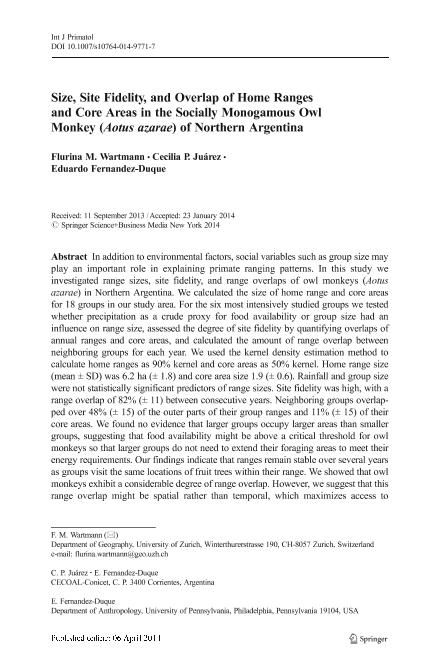Artículo
Size, site fidelity, and overlap of home ranges and core areas in the socially monogamous owl monkey (aotus azarae) of northern Argentina
Fecha de publicación:
04/2014
Editorial:
Springer/plenum Publishers
Revista:
International Journal of Primatology
ISSN:
0164-0291
e-ISSN:
1573-8604
Idioma:
Inglés
Tipo de recurso:
Artículo publicado
Clasificación temática:
Resumen
In addition to environmental factors, social variables such as group size may play an important role in explaining primate ranging patterns. In this study we investigated range sizes, site fidelity, and range overlaps of owl monkeys (Aotus azarae) in Northern Argentina. We calculated the size of home range and core areas for 18 groups in our study area. For the six most intensively studied groups we tested whether precipitation as a crude proxy for food availability or group size had an influence on range size, assessed the degree of site fidelity by quantifying overlaps of annual ranges and core areas, and calculated the amount of range overlap between neighboring groups for each year. We used the kernel density estimation method to calculate home ranges as 90% kernel and core areas as 50% kernel. Home range size (mean ± SD) was 6.2 ha (± 1.8) and core area size 1.9 (± 0.6). Rainfall and group size were not statistically significant predictors of range sizes. Site fidelity was high, with a range overlap of 82% (± 11) between consecutive years. Neighboring groups overlapped over 48% (± 15) of the outer parts of their group ranges and 11% (± 15) of their core areas. We found no evidence that larger groups occupy larger areas than smaller groups, suggesting that food availability might be above a critical threshold for owl monkeys so that larger groups do not need to extend their foraging areas to meet their energy requirements. Our findings indicate that ranges remain stable over several years as groups visit the same locations of fruit trees within their range. We showed that owl monkeys exhibit a considerable degree of range overlap. However, we suggest that this range overlap might be spatial rather than temporal, which maximizes access to clumped feeding resources in overlapping areas that are used at distinct times, while excluding other males from access to females in exclusively used areas.
Archivos asociados
Licencia
Identificadores
Colecciones
Articulos(CECOAL)
Articulos de CENTRO DE ECOLOGIA APLICADA DEL LITORAL (I)
Articulos de CENTRO DE ECOLOGIA APLICADA DEL LITORAL (I)
Citación
Wartmann, Flurina M.; Juárez, Cecilia Paola; Fernandez Duque, Eduardo; Size, site fidelity, and overlap of home ranges and core areas in the socially monogamous owl monkey (aotus azarae) of northern Argentina; Springer/plenum Publishers; International Journal of Primatology; 35; 5; 4-2014; 919-939
Compartir
Altmétricas




